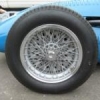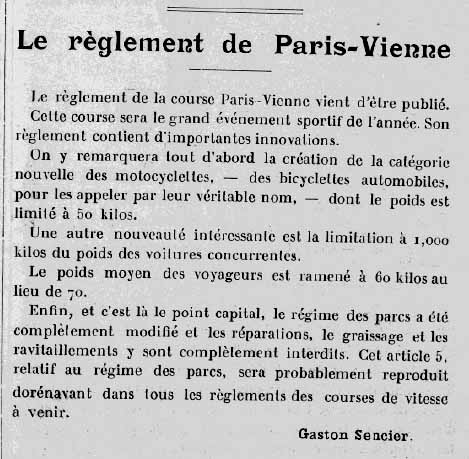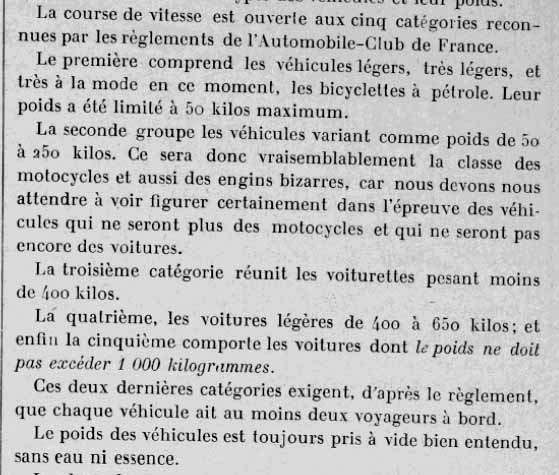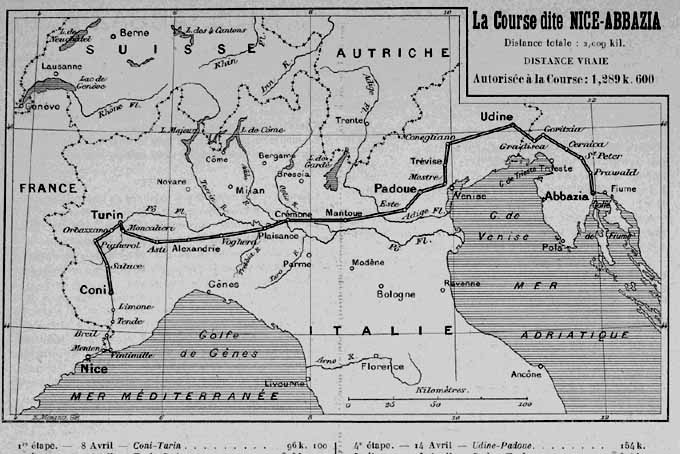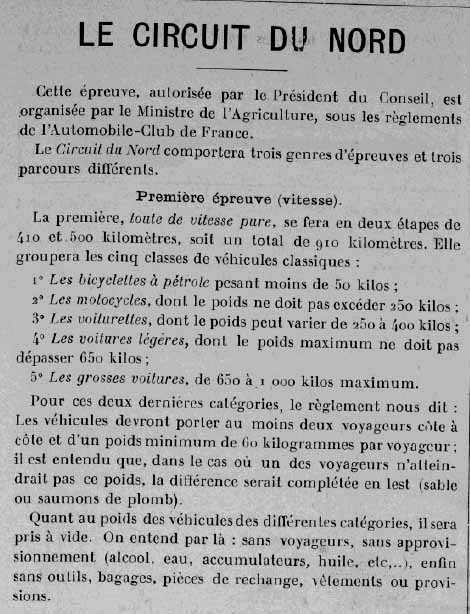The first competition that was run according to a 'formula' was actually the very first "proper" motor race of all, the 1895 Paris-to-Bordeaux-and-back race: it had two classes, one for
voitures automobile, defined by having (at least) two seats side-by-side, and one for (motor) cycles, which were limited to a weight of no more than 150 kg. The entry for the latter included vehicles of two, three and four wheels, though only a couple of motor bicycles made the start, and none finished. The main automobile class was a "free-for-all", "Formula Libre" event, if you will, although the rules stipulated that the winner of first prize had to seat more than two persons. This did not prevent the entry of half a dozen two-seaters, two of which completed the race before anyone else, so first prize went to a four-seater which had finished third on time.
The following year, races at Bordeaux, Spa and Lyon were held to basically the same rules, it seems, before the ACF exercised its role as leader of the sport by introducing new formulae for the big event in autumn, two each for automobiles and cycles, as detailed by Sterzo in post #6. There was, however, also a third class, called
divers by the French, which catered for all vehicles not covered by the aforementioned classes: too heavy for a cycle (more than 150 kg), and not qualifying as a
voiture automobile - remember, two seats
side-by-side! At the time, only the Léon Bollée "tricars" entered for that class, and they were commercially known as "voiturettes" - not a proper car, but more than a mere cycle.
Throughout 1897, in which year the ACF failed to organise a big race (and thus, also failed to introduce new rules), most race organisers followed the same pattern and posted two classes only, one for automobiles and one for cycles, but raising the weight limit for the latter to 200 kg so as to accomodate the voiturettes as well. Only the Paris-to-Dieppe race appears to have diverted from this pattern, by having two seperate classes for cycles and three for automobiles (again based on number of seats). In spring of 1898, the Automobile Club de Nice finally formulated the breakthrough formulae, mentioned by Sterzo in post #6. It was the most sensible solution so far, and only the fact that it wasn't invented by the ACF stopped it from becoming an immediate and universally accepted pattern. As it was, the ACF continued for two more years with a system based on their own, 1896 rules, but pretty much everyone else, in France and elsewhere, copied the AC Nice formulae to some extent, although the actual weight figures varied some.
By 1901, the general pattern was for Heavy Cars to weigh over 650 kg, Light Cars from 400 to 650 kpg, Voiturettes from 250 to 400 kg and Motor Cycles under 250 kg, and the following year Heavy Cars were usually capped at 1000 kg maximum. For a while, Heavy and Light Car classes tended to be combined into one race, while Voiturettes usually ran with the Motor Cycles, which soon developed a sub-class for
motocyclettes at 50 kg, basically a two-wheel-only class. This old system finally faded away with the big ACF races, and the last big meeting which at least formally held on to these rules was the 1905 Circuit des Ardennes, if I'm not mistaken. In the fall of that same year, the Coupe de l'Auto stepped into the void by creating its own set of rules for the next ten years or so, leading to much confusion amongst some researchers.
The pattern for the years 1905 following, was that the
Association International des Automobile Clubs Reconnus (AIACR) and the
Fédération Internationale de Motocyclisme (FIM), both founded during the year 1904, finalised the rules for the Heavy Car and Motor Cycle classes, with the Coupe de l'Auto (named after a car magazine) effectively making the rules for the "Voiturette class", the Light Cars disappearing from sight for a time, much like in the Formula Junior years (1958 to '63). This also opened the door for more complex formulae, not based simply on total weight, and for a good time maximum bore formulae were very popular, which led to some very bizarre designs, especially in the Voiturette class. Thus, l'Auto decided to revive the Light Car class in 1911 with a formula based on engine capacity alone, a concept already tried by the German club for the 1907 Kaiserpreis race, and although very successful at the time, not repeated since.
L'Auto was rewarded with a superb entry for the 1911 Light Car race, and the Voiturette class died quietly away, while the Light Cars went from strength to strength, even competing with the Heavy Cars in the 1912 Grand Prix, and giving a very good account of themselves. Meanwhile, the FIM (i.e. the international motorcycle sanctioning club!) in 1913 introduced the "Cyclecar" class, effectively voiturettes under a new name, bringing the class "home" again to its roots with the Motor Cycles of the late 19th century. Thus, in 1914 at last, all the major categories in car racing were based on capacity limits: Heavy Cars, now mostly known as Grand Prix cars at 4500 cc, Light Cars at 3000 cc, and Cycle Cars at 1100 cc (although there was often a sub-category for 750 cc cars as well).
The war interrupted all this, and when it was over there was a distinct lack of direction for a time, with the Targa Florio even reverting to a maximum bore formula once again, but from 1920 onwards basically all top racing events in Europe were governed by capacity classes. For several more years, motorcycle clubs continued to organise cyclecar races, with capacity limits of 750, 1100, 1400 or even 1500 cc, while other events usually "cut their clothes" according to what was available. At some point in the early twenties, and I'm still trying to find out when exactly, the AIACR introduced formal classes A to J, according to the following list, and soon race organisers began adopting those, although their main aim was to make record keeping more efficient:
A: over 8000 cc
B: 5000 to 8000 cc
C: 3000 to 5000 cc
D: 2000 to 3000 cc
E: 1500 to 2000 cc
F: 1100 to 1500 cc
G: 750 to 1100 cc
H: 500 to 750 cc
I: 350 to 500 cc
J: up to 350 cc
Naming conventions went a bit to the wind in those years, while the limit for Grand Prix cars (traditionally, the "Heavy Car" class) came down to eventually 1500 cc in 1926 - that was hardly "heavy", or "big" as in the original French term "Grosse Voiture"! Basically, those were effectively "Light Cars", competing as Grand Prix cars, a situation much the same as in 1961 to '65. By 1926, the 1100 cc and 750 cc classes were almost universally called Voiturette and Cyclecar classes, respectively, although they were often described by their capacity alone, and that continued after the Grand Prix limit of 1500 cc was lifted again. The 1500 cc cars continued to race, often simply as "Fifteenhundreds", and sometimes as Light Cars - I have
never seen one of those races or the formula called "Voiturette" in period sources of the time; it is simply a historical and linguistic mistake to call an ERA or a 6CM Maserati a voiturette, or in continuation of this a March 782, or a Reynard 89D! Sadly, since the publication of the "Black Books", that mistake has made it into print, and will be difficult to erase. But the real voiturette of these days is the Formula 3 car, ever since its inception as a 500 cc racing car, and still today (unlike the Formula 2/3000 Light Car) markedly different from a full-size Grand Prix car - not a proper car, but more than a mere cycle!
Edited by Michael Ferner, 10 May 2018 - 17:50.



